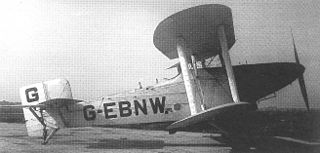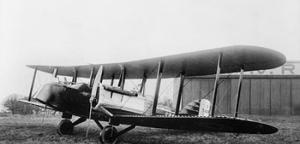
The Avro 549 Aldershot was a British single-engined bomber aircraft built by Avro.

The Avro 555 Bison was a British single-engined fleet spotter/reconnaissance aircraft built by Avro.

The Avro 566 Avenger was a prototype British fighter of the 1920s, designed and built by Avro. It was a single-seat, single-engine biplane of wood and fabric construction. Although it was a streamlined and advanced design, it never entered production.

The Avro Type 584 Avocet was a British single-engined naval fighter prototype, designed and built by Avro. While the Avocet was not built in numbers, one of the prototypes was used as a seaplane trainer for the Royal Air Force's (RAF) High Speed Flight.

The Avro 560 was a British single-engined ultralight monoplane built by Avro at Hamble Aerodrome.

The Avro 571 Buffalo was a prototype British carrier-based torpedo bomber biplane, designed and built by Avro in the 1920s. It was not selected for service, the Blackburn Ripon being ordered instead.

The Avro 604 Antelope was a British light bomber which was designed and built in the late 1920s to meet a requirement for a light bomber to equip the Royal Air Force, competing against the Hawker Hart and the Fairey Fox II. It was unsuccessful, the Hart being preferred.

The Avro 627 Mailplane was a British biplane developed in 1931 by Avro from the Avro Antelope bomber as a mail plane for use in Canada. Only one was built which ended up being used as a test bed.
The Roe I Biplane was the first powered aircraft to be designed, built, and flown in England. Designed in an attempt to claim a prize offered by the Brooklands Automobile Racing Club, it was designed and built by Alliott Verdon Roe, who based it on a powered model with which he had won a Daily Mail prize of £75 at Alexandra Palace in April 1907. This prize was substantially larger: the club committee was offering £2,500 for the first person to fly a circuit of their three-mile (4.8 km) race track by the end of the year. In addition the Daily Graphic was offering a £1,000 prize for a flight of more than a mile (1.6 km).

The Avro 641 Commodore was a British single-engine five-seat cabin biplane built by Avro in the mid-1930s for private use. A total of only six were built, including the prototype.

The Roe I Triplane was an early aircraft designed and built by A.V. Roe which was the first all-British aircraft to fly..

The Avro Type E, Type 500, and Type 502 made up a family of early British military aircraft, regarded by Alliott Verdon Roe as his firm's first truly successful design. It was a forerunner of the Avro 504, one of the outstanding aircraft of the First World War.

The Avro 523 Pike was a British multi-role combat aircraft of the First World War that did not progress past the prototype stage. It was intended to provide the Royal Naval Air Service with an anti-Zeppelin fighter that was also capable of long-range reconnaissance and light bombing.

The Avro 531 Spider was a British fighter aircraft built by Avro during the First World War. It did not proceed past the prototype stage.

The Avro 534 Baby was a British single-seat light sporting biplane built shortly after the First World War.

The Avro 547 was a prototype triplane airliner developed in Britain after the First World War. It utilised components from the highly successful 504 but added an extra set of wings and a new deep fuselage housing a fully enclosed cabin to seat four passengers. The aircraft was powered by a 160 hp (120 kW) Beardmore engine. The pilot sat in an open cockpit offset to port. The prototype flew well, having similar characteristics to a 504, the second example built was substantially modified, in order to compete in a British Air Ministry competition for a commercial aircraft, being fitted with a 240 hp (180 kW) Siddeley Puma engine. Designated 547A, this version turned out to be slow and unstable in the air and failed to win an award in the competition in August 1920. Damaged in a forced landing at the competition, the second prototype was scrapped in 1922.

The Avro Type 557 Ava was a British twin-engined biplane torpedo bomber of the 1920s. It was developed by Avro to meet a requirement for a heavy torpedo bomber for the Royal Air Force, but was unsuccessful, only two prototypes being built.
The Avro 521 was a British two-seat fighter first flown in late 1915, based on the 504. Only a prototype of the Avro 521 was built. It was powered by a 110 hp (80 kW) Clerget engine, with provision for a .303 in (7.7 mm) Lewis Gun in the rear cockpit.

The Avro 533 Manchester was a First World War-era twin-engine biplane photo-reconnaissance and bomber aircraft designed and manufactured by Avro.
The Avro 511 was designed as a fast scouting aircraft just before the First World War. Modified, it became the Avro 514. Though it had innovative features, development did not continue after the start of hostilities.

























